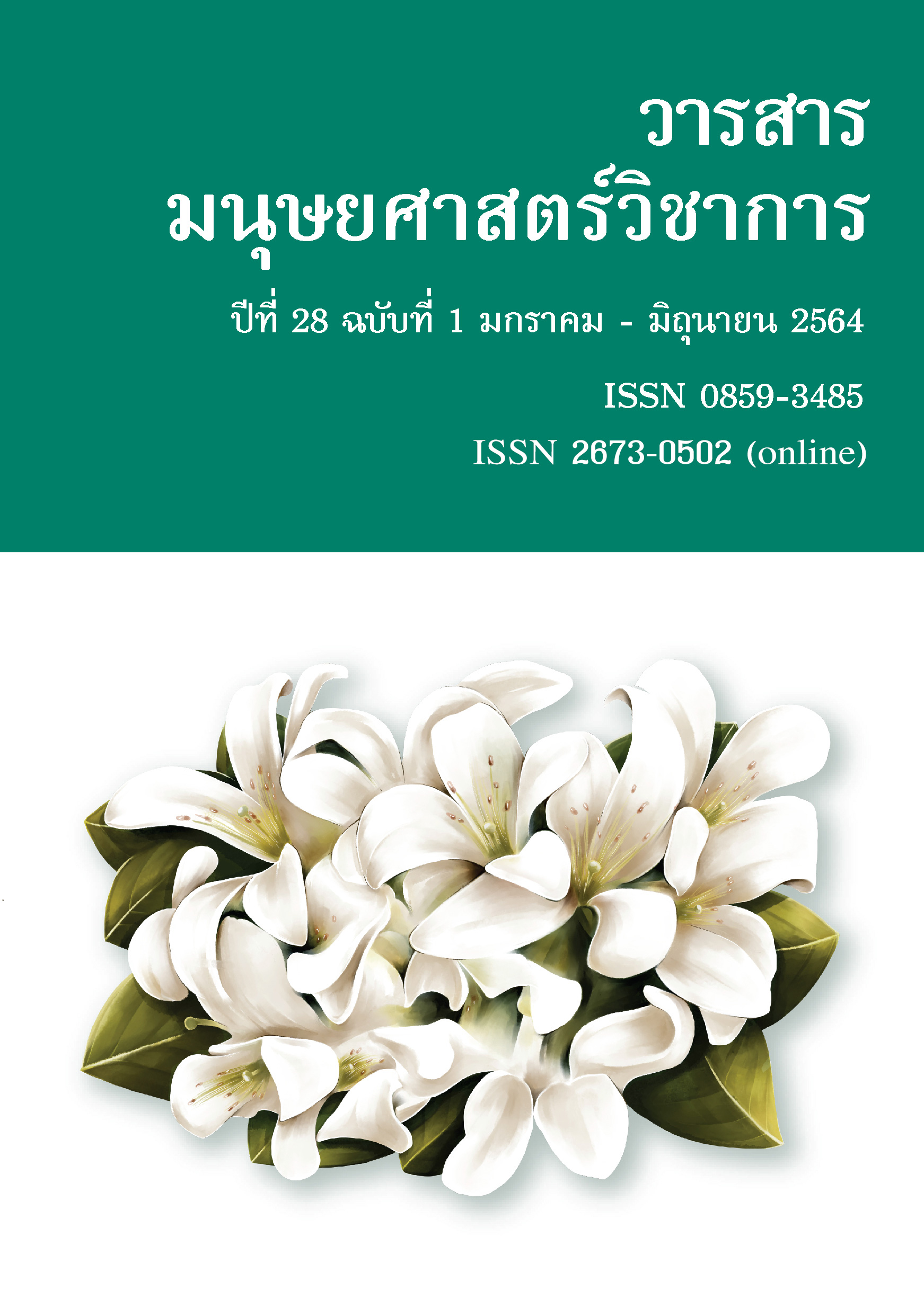จังหวะการพูดภาษาไทยของผู้พูดภาษามลายูถิ่นปัตตานีเป็นภาษาแม่ตามแนวคิดแบบจารีตกับแนวคิดแบบจำลองการเกาะกุล่มภาษา
Main Article Content
บทคัดย่อ
งานวิจัยนี้มีวัตถุประสงค์เพื่อศึกษาเปรียบเทียบจังหวะการพูดภาษาไทยของผู้พูดภาษามลายูถิ่นปัตตานีเป็นภาษาแม่ที่มีสมรรถภาพในการพูดภาษาไทยต่างระดับกัน โดยใช้แนวคิดแบบจารีต (Traditional Temporal Approach) เปรียบเทียบกับแนวคิดแบบจำลองการเกาะกลุ่มภาษา (Rhythm Metrics Approach) 3 แบบ
ได้แก่ แบบจำลองการเกาะกลุ่มภาษาของ Ramus et al. (1999) Grabe & Low (2002) และ Dellwo et al. (2007) ผู้ให้ข้อมูลภาษาเป็นผู้พูดภาษามลายูถิ่นปัตตานีเป็นภาษาแม่ที่มีสมรรถภาพในการพูดภาษาไทยต่างระดับกัน 2 กลุ่ม ได้แก่ กลุ่มที่มีสมรรถภาพในการพูดภาษาไทยระดับดีมากกับระดับกลาง กลุ่มละ 5 คน อายุ
ระหว่าง 18-21 ปี ทั้งหมดเป็นเพศหญิง ข้อมูลที่ใช้ในการวิเคราะห์เป็นข้อมูลจากคำพูดต่อเนื่อง โดยใช้อัตราเร็วในการพูดปานกลาง (Moderate) ใช้เวลาในการวัดและวิเคราะห์คำพูดต่อเนื่องไม่น้อยกว่า 30 วินาทีต่อผู้ให้ข้อมูลภาษา 1 คน
ผลการวิจัยพบว่า จังหวะการพูดภาษาไทยตามแนวคิดแบบจารีตของผู้พูดภาษามลายูถิ่นปัตตานีเป็นภาษาแม่ทั้งสองกลุ่ม มีแนวโน้มเป็นจังหวะการพูดที่มีพยางค์เป็นหน่วยกำหนดจังหวะ อย่างไรก็ตาม พบว่า ค่าระยะเวลาเฉลี่ยของพยางค์ที่ไม่ได้รับการลงเสียงเน้นหนักอย่างมีนัยสำคัญทางสถิติ (p < 0.05) สำหรับประสิทธิภาพของแนวคิดแบบจำลองการเกาะกลุ่มภาษาทั้ง 3 แบบสามารถสะท้อนประเภทของจังหวะการพูดภาษาไทยของผู้ให้ข้อมูลภาษาได้แต่ไม่สามารถระบุได้ชัดเจนว่าประเภทของจังหวะการพูดเป็นแบบใด
Article Details
References
ญาณินท์ สวนะคุณานนท์. (2555). ค่าระยะเวลาของเสียงเรียงในภาษาเอเชียตะวันออกเฉียงใต้: นัยสำคัญต่อการจัดกลุ่มตามแนวแบบลักษณ์ภาษา (วิทยานิพนธ์อักษรศาสตรดุษฎีบัณฑิต). จุฬาลงกรณ์มหาวิทยาลัย, กรุงเทพฯ.
ณัฐพงษ์ พึ่งน้อย. (2553). การศึกษาลักษณะทางกลสัทศาสตร์ของพยางค์ที่ได้รับการลงเสียงหนักและพยางค์ที่ไม่ได้รับการลงเสียงหนักในภาษามลายูถิ่นปัตตานีและภาษาอูรักลาโวยอ์ (วิทยานิพนธ์อักษรศาสตรมหาบัณฑิต). จุฬาลงกรณ์มหาวิทยาลัย, กรุงเทพฯ.
รัตติยา สาและ. (2534). ภาษามลายูถิ่นภาคใต้ของประเทศไทย. สงขลา: โครงการบริหารการศึกษา มหาวิทยาลัยศรีนครินทรวิโรฒ สงขลา.
อมร ทวีศักดิ์. (2530). ภาษามลายูถิ่นในประเทศไทย: ผลงานการวิจัย. นครปฐม: สถาบันวิจัยภาษาและวัฒนธรรมเพื่อพัฒนาชนบท มหาวิทยาลัยมหิดล.
Abercrombie, D. (1967). Elements of General Phonetics. Chicago: Aldine.
Arvaniti, A. (2009). Rhythm, timing and the timing of rhythm . Phonetica, 66(1-2), 46-63.
Barbosa, P. A. (2000). Syllable-timing in Brazilian Portuguese: uma crítica a Roy Major. D.E.L.T.A., 16(2), 369-402.
Bolinger, D.L. (1965). Pitch accent and sentence rhythm. In I. Abe & T. Kanekiyo (Eds.), Forms of English: Accent, Morpheme, Order. Cambridge: Harvard University Press.
Dasher, R. & Bolinger, D.L. (1982). On pre-accentual lengthening. Journal of the International Phonetic Association, 12, 58-69.
Dauer, R.M. (1983). Stress-timing and syllable-timing reanalyzed. Journal of Phonetics, 11, 51-62.
Dauer, R.M.(1987). Phonetic and phonological components of language rhythm. In Proceedings of the ICPhS XI, (pp.447-449). Tallinn, Estonia.
Dellwo, V., Fourcin, A., & Abberton, E. (2007). Rhythmical classification of languages based on voice parameters. in Proceedings of the XVIth ICPhS, (pp. 1129-1132). Saarbrücken, Germany.
Dellwo, V., & P. Wagner, (2003). Relations between language rhythm and speech rate. in M. J. Sole, D. Recasens & J. Romeo (Eds.), Proceedings of the 15th International Congress of Phonetics Sciences (pp. 471-474). Barcelona: Futurgraphic.
Deterding, D. (2011). Measurements of the rhythm of Malay. in Proceedings of the ICPhS XVII, (pp. 576-579). Hong Kong.
Grabe, E. & Low, E.L. (2002). Durational variability in speech and the rhythm class hypothesis. In Gussenhoven, C. & Warner, N. (Eds.), Laboratory Phonology, 7, 515-546.
Hyman, L.M. (2009). How (not) to do phonological typology: The case of pitch-accent. Language Sciences, 31, 213-238.
L. Thongkum. (1984, August 22-24). Rhythmic groups and stress groups in Thai. Paper presented at the International Conference on Thai Studies. Bangkok, Thailand.
Laver, J. (1994). Principles of Phonetics. Cambridge: Cambridge University Press.
Luangthongkum, T. (1977). Rhythm in Standard Thai (Unpublished doctoral dissertation). University of Edinburgh, UK.
Major, R. C. (1981) Stress-timing in Brazilian Portuguese. Journal of Phonetics, 9, 343-351.
Meireles A.R., Tozetti, J.P. & Borges, R.R. (2010). Speech rate and rhythmic in Brazilian Portuguese. In Proceedings of the Speech Prosody 2010 Conference, (pp.1-4). Chicago.
Otake, T., Hatano, G., Cutler, A. & Mehler, J. (1993). Mora or syllable? Speech segmentation in Japanese. Journal of Memory and Language, 32 (2), 258-278.
Pike, K.L. (1946). The Intonation of American English. Ann Arbor: University of Michigan Press.
Ramus, F., Nespor, M. & Mehler, J. (1999). Correlates of linguistic rhythm in the speech signal. Cognition, 73, 265-292.
Roach, P. (1982). On the distinction between “stress-timed” and “syllable-timed” languages. In D. Crystal (Ed.), Linguistic Controversies: Essays in Linguistic Theory and Practice in Honour of F.R. Palmer, (pp. 73-79). London: Arnold.
Steele, J. (1775). An Essay towards Establishing the Melody and Measure of Speech. London. Wan Aslynn Salwani Wan Ahmad. (2012). Instrumental Phonetic Study of the Rhythm of Malay (Unpublished doctoral dissertation). Newcastle University, Newcastle.
Warner, N., & Arai, T. (2001). Japanese mora-timing: A review. Phonetica, 58, 1-25.

